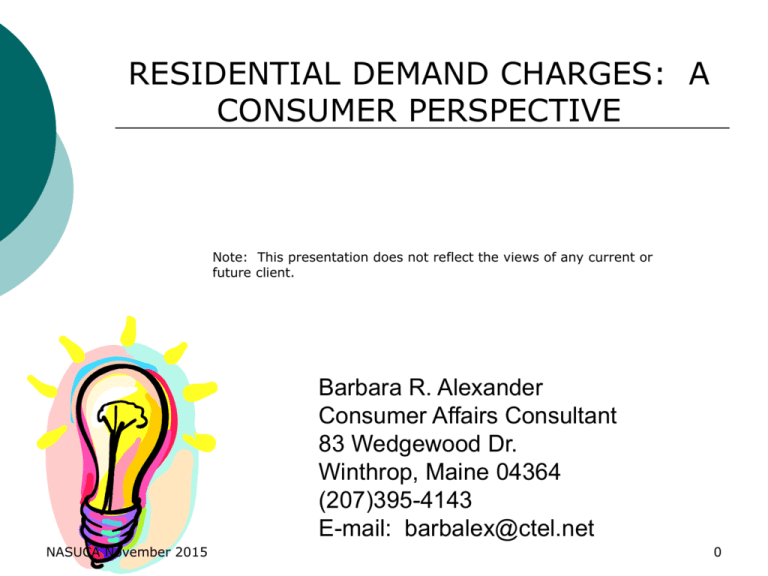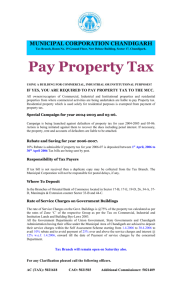Barbara Alexander
advertisement

RESIDENTIAL DEMAND CHARGES: A CONSUMER PERSPECTIVE Note: This presentation does not reflect the views of any current or future client. Barbara R. Alexander Consumer Affairs Consultant 83 Wedgewood Dr. Winthrop, Maine 04364 (207)395-4143 E-mail: barbalex@ctel.net NASUCA November 2015 0 DEMAND CHARGES What are we talking about here? Generally, a move to require residential customers to pay more in fixed charges and less in variable kWh charges Demand Rates: charge a fee that varies each month based on the customer’s highest actual demand (kW), measuring appliance and device usage at certain “peak periods.” Increased monthly charge: charge a fixed fee that shifts some distribution costs into monthly customer charge NASUCA November 2015 1 DEMAND CHANGES REQUIRE ADVANCED OR DIGITAL METERS One of the key motivations for proposing demand charges and other “dynamic” rates is the presence of advanced or digital meters Demand changes require customer usage data on at least hourly increments (but customers don’t see this information!) We knew this would happen! NASUCA November 2015 2 CURRENT TRENDS: USING LESS AND PAYING MORE Efficiency Programs Smart Meter Mandates Renewable Energy Mandates Distributed Generation and Solar PV Mandates: Net Metering Subsidy Shifted to other ratepayers Enhanced Storm Resiliency and Distribution Infrastructure Investments Transmission Costs: Federal and State In some states, costs of low income discount or bill assistance programs NASUCA November 2015 3 Energy Expenditures: Age 50+ NASUCA November 2015 4 ELECTRICITY IS LARGEST EXPENDITURE NASUCA November 2015 5 CURRENT TRENDS: RATE DESIGN IS A ZERO SUM GAME Whatever the level of rate charges, the entire rate design must recover the test year revenue requirement for each class. For every dollar that is recovered via fixed or demand charges, a dollar less needs to be recovered from the energy charge. The converse is also true. Utilities are protected with “bill stabilization,” “decoupling,” and “lost sales revenue” mechanisms OR THEY WILL FILE A RATE CASE NASUCA November 2015 6 DEMAND CHARGES: COMPLEX RATE DESIGN ISSUES Is this charge linked to distribution service in restructuring states? How would this charge be integrated with the pass through of default generation supply service? Is this individual peak demand or system peak demand? How calculate the value in terms of customer response for peak load reduction and impact on generation supply prices? [What if you don’t need peak load reduction?] Does this kW demand charge change monthly? Annually? Does this rate option require expensive AMI systems? [Yes] Consider costs of education, customer interaction, complaints, and political backlash. NASUCA November 2015 7 WHO ARE THE LOSERS? Whose bill will increase with demand charges or fixed monthly charges? Who pays for mandates and subsidies for efficiency and solar programs? Low use customers Low income and fixed income customers Renters/multi-unit residents NASUCA November 2015 8 WHO ARE THE WINNERS? Who are those who are likely to benefit from demand rates and higher fixed monthly charges? Upper income: investments in home improvements, new technologies and appliances; income or credit rating to purchase solar Better education: understand complex rate designs and bills; time and energy to learn and respond Single Family Homeowner NASUCA November 2015 9 RESIDENTIAL DEMAND CHARGES Is this being promoted to ensure that solar PV customers pay their fair share? In response to the scare that Distributed Generation will eliminate utility revenue streams? Consider alternative rates for solar PV customers and customers with electric vehicles Don’t overreact to DG; it is still a pretty small portion of generation supply and the “solar on every roof” vision is impractical and very inefficient NASUCA November 2015 10 RESIDENTIAL DEMAND CHARGES Is this being promoted to respond to the utility “death spiral” and loss of sales revenues? Where are the efficiencies and performance standards? Proliferation of unregulated affiliates and mergers and acquisitions to benefit shareholders The “death spiral” is highly overrated in actual fact. NASUCA November 2015 11 SENDING THE “PROPER PRICE SIGNAL” First, you have to understand the “signal” being sent. Second, you have to have the means to respond. When the bill is “unbundled” and the rate tiers proliferate and the surcharges are listed, what is the “signal” and who can understand it? Utilities emphasize the total bill and require payment to avoid disconnection NASUCA November 2015 12 CAN YOU UNDERSTAND THIS PRICE SIGNAL? NASUCA November 2015 13 CUSTOMER UNDERSTANDING: Georgia Power Optional Residential Demand Rate There are two ways to manage your bill on the Residential Demand Rate: Avoid simultaneous use of major appliances. If you can avoid running appliances at the same time, then your peak demand would be lower. This translates to less demand on Georgia Power Company, and savings for you! Each month the demand resets after your meter is read. Shift energy usage away from the On-Peak time periods (2 PM – 7 PM, Monday – Friday, June-September, excluding holidays). Here are four ways to shift usage: Use a programmable thermostat to increase the temperature in your home to 78-80 degrees during summer weekdays Use a timer on your water heater Avoid using major appliances such as washers, dryers and dishwashers during the peak time period Use a timer on your pool pump so that it automatically shuts off Who could benefit from the Residential Demand Rate? Customers who pay attention to WHAT appliances are running and WHEN the appliances are running Customers who have a programmable thermostat and have timers on other appliances NASUCA November 2015 14 ARIZONA HAS A SUCCESSFUL DEMAND RATE OPTION Arizona Public Service: 11% of their residential customers enrolled on a TOU demand rate option Rate calculator on website Promoted to customers with high monthly average use and timers; demand based TOU average monthly usage is 2,000 kWh compared to 700 kWh on inclining block rate or 1,300 kWh for energy only TOU rate. Rates range from 4.4 cents for off peak to 8.8 cents on peak; demand charge is $13.50 kW in summer and $9.30 per kW in winter VERY TARGETED AND REFLECTS CLIMATE AND USAGE CRITERIA; bundled service NASUCA November 2015 15 DO YOU REALLY BELIEVE MOST CUSTOMERS CARE ABOUT HOURLY PRICES AND “DEMAND” FACTORS FOR THEIR APPLIANCES? Customers will be engaged if the options are understandable, easy to implement, automated where possible, result in measurable bill savings, and presented by a trusted advisor; Most Likely Success with Peak Time Rebates and Direct Load Control (“set it and forget it”) The market for solar PV is possible only with taxpayer and ratepayer subsidies that are not sustainable in their current form in the long run NASUCA November 2015 16 RATE DESIGN PRINCIPLES Who are the winners and losers? Bill impacts are key to develop and consider by regulators Consider short term costs and long term estimated predictions; risk analysis is crucial to identify and consider since we know from experience that regulators and policy wonks do not predict the future accurately Can you explain it to customers without technical jargon or economic theory? Is it fair to lower use, low income, fixed income and multi-unit customers? Are you predicting generation supply cost reductions? Or other predicted benefits in performance or affordability? Who assumes the risk of achieving these benefits? NASUCA November 2015 17 RATE DESIGN POLICIES Default rate design for residential customers should be based on bill stability and kWh usage Customer charges should reflect costs of customer specific charges and not common distribution charges Demand charge rates are highly unlikely to be reasonable or appropriate for vast majority of residential customers Offering rate options may be reasonable but should be approved only where benefits to all customers exceed the costs Solar PV customers should pay their fair share of distribution services and costs NASUCA November 2015 18 BIBLIOGRAPHY Bornstein, Severin, “Is the Future of Electric Generation Really Distributed?”, https://energyathaas.wordpress.com/ Allcott, Knittel, Taubinsky, “Tagging and Targeting of Energy Efficiency Subsidies,” E2w Working Paper (May 2015) http://e2e.haas.berkeley.edu/pdf/workingpapers/WP018.p df#page=1 Costello, Kenneth, “Not so Fast: Why the Electric Industry May be Heading in the Wrong Direction,” Public Utilities Fortnightly (March 2015) Lazar, Jim and Gonzalez, Wilson, “Smart Rate Design for a Smart Future,” Regulatory Assistance Project (July 2015): http://raponline.org/document/download/id/7680 Alexander, Barbara, “An Analysis of State Renewable Energy and Distributed Generation Mandates on Low Income Consumers: Recommendations for Reform NASUCA November 2015 19 (September 2014)








